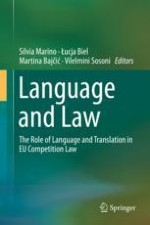2018 | OriginalPaper | Chapter
A Mutual Learning Exercise in Terminology and Multilingual Law
Authors : Martina Bajčić, Adrijana Martinović
Published in: Language and Law
Publisher: Springer International Publishing
Activate our intelligent search to find suitable subject content or patents.
Select sections of text to find matching patents with Artificial Intelligence. powered by
Select sections of text to find additional relevant content using AI-assisted search. powered by
